
Chapter 13 Membrane Channels and Pumps Matching Questions Use the following to answer questions 1-10: Choose the correct answer from the list below.Not all of the answers will be used a)aspartic acid b)gap junctions c)digitalis d)action potential e)cotransporters f)ABC proteins g)lipophilic h)acetylcholine i)ATPases j)connexin k)patch-clamp 1)antiporter 1 These membrane proteins transport two species in opposite directions across the membrane. Ans:I Section:Introduction 2 This type of molecule can diffuse across a membrane without the aid of a transporter protein. Ans:g Section:13.1 3 P-type ATPases transfer a phosphor group to this amino acid residue side chain. Ans:a Section:13.2 A plant extract of steroids used to treat heart failure. Ans:c Section:13.2 This family of transport proteins possesses a separate domain or cassette that specifically binds ATP. Ans:f Section:13.3
Chapter 13 Membrane Channels and Pumps Matching Questions Use the following to answer questions 1-10: Choose the correct answer from the list below. Not all of the answers will be used. a) aspartic acid b) gap junctions c) digitalis d) action potential e) cotransporters f) ABC proteins g) lipophilic h) acetylcholine i) ATPases j) connexin k) patch-clamp l) antiporter 1 ____________ These membrane proteins transport two species in opposite directions across the membrane. Ans: l Section: Introduction 2 ____________ This type of molecule can diffuse across a membrane without the aid of a transporter protein. Ans: g Section: 13.1 3 ____________ P-type ATPases transfer a phosphor group to this amino acid residue side chain. Ans: a Section: 13.2 4 ____________ A plant extract of steroids used to treat heart failure. Ans: c Section: 13.2 5 ____________ This family of transport proteins possesses a separate domain or cassette that specifically binds ATP. Ans: f Section: 13.3
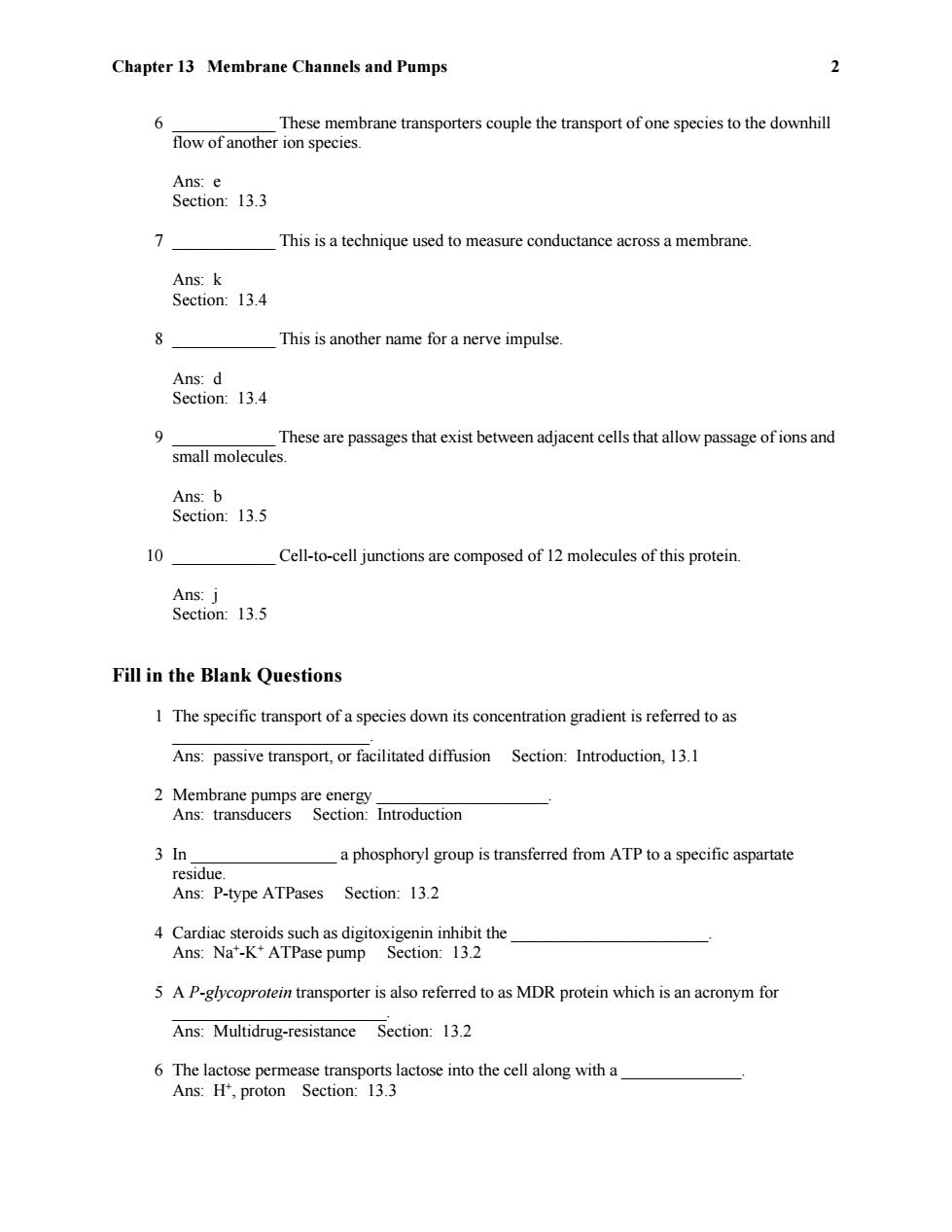
Chapter 13 Membrane Channels and Pumps 2 6 These membrane transporters couple the transport of one species to the downhill flow of another ion species. Ans:e Section:13.3 7 This is a technique used to measure conductance across a membrane. Ans:k Section:13.4 8 This is another name for a nerve impulse. Ans:d Section:13.4 9 These are passages that exist between adjacent cells that allow passage of ions and small molecules. Ans:b Section:13.5 10 Cell-to-cell junctions are composed of 12 molecules of this protein Ans:j Section:13.5 Fill in the Blank Questions 1 The specific transport of a species down its concentration gradient is referred to as Ans:passive transport,or facilitated diffusion Section:Introduction,13.1 2 Membrane pumps are energy Ans:transducers Section:Introduction 3 In a phosphoryl group is transferred from ATP to a specific aspartate residue. Ans:P-type ATPases Section:13.2 4 Cardiac steroids such as digitoxigenin inhibit the Ans:Na'-K*ATPase pump Section:13.2 5 A P-glycoprotein transporter is also referred to as MDR protein which is an acronym for Ans:Multidrug-resistance Section:13.2 6 The lactose permease transports lactose into the cell along with a Ans:H',proton Section:13.3
Chapter 13 Membrane Channels and Pumps 2 6 ____________ These membrane transporters couple the transport of one species to the downhill flow of another ion species. Ans: e Section: 13.3 7 ____________ This is a technique used to measure conductance across a membrane. Ans: k Section: 13.4 8 ____________ This is another name for a nerve impulse. Ans: d Section: 13.4 9 ____________ These are passages that exist between adjacent cells that allow passage of ions and small molecules. Ans: b Section: 13.5 10 ____________ Cell-to-cell junctions are composed of 12 molecules of this protein. Ans: j Section: 13.5 Fill in the Blank Questions 1 The specific transport of a species down its concentration gradient is referred to as _______________________. Ans: passive transport, or facilitated diffusion Section: Introduction, 13.1 2 Membrane pumps are energy ____________________. Ans: transducers Section: Introduction 3 In _________________ a phosphoryl group is transferred from ATP to a specific aspartate residue. Ans: P-type ATPases Section: 13.2 4 Cardiac steroids such as digitoxigenin inhibit the _______________________. Ans: Na + -K+ ATPase pump Section: 13.2 5 A P-glycoprotein transporter is also referred to as MDR protein which is an acronym for _________________________. Ans: Multidrug-resistance Section: 13.2 6 The lactose permease transports lactose into the cell along with a ______________. Ans: H+ , proton Section: 13.3
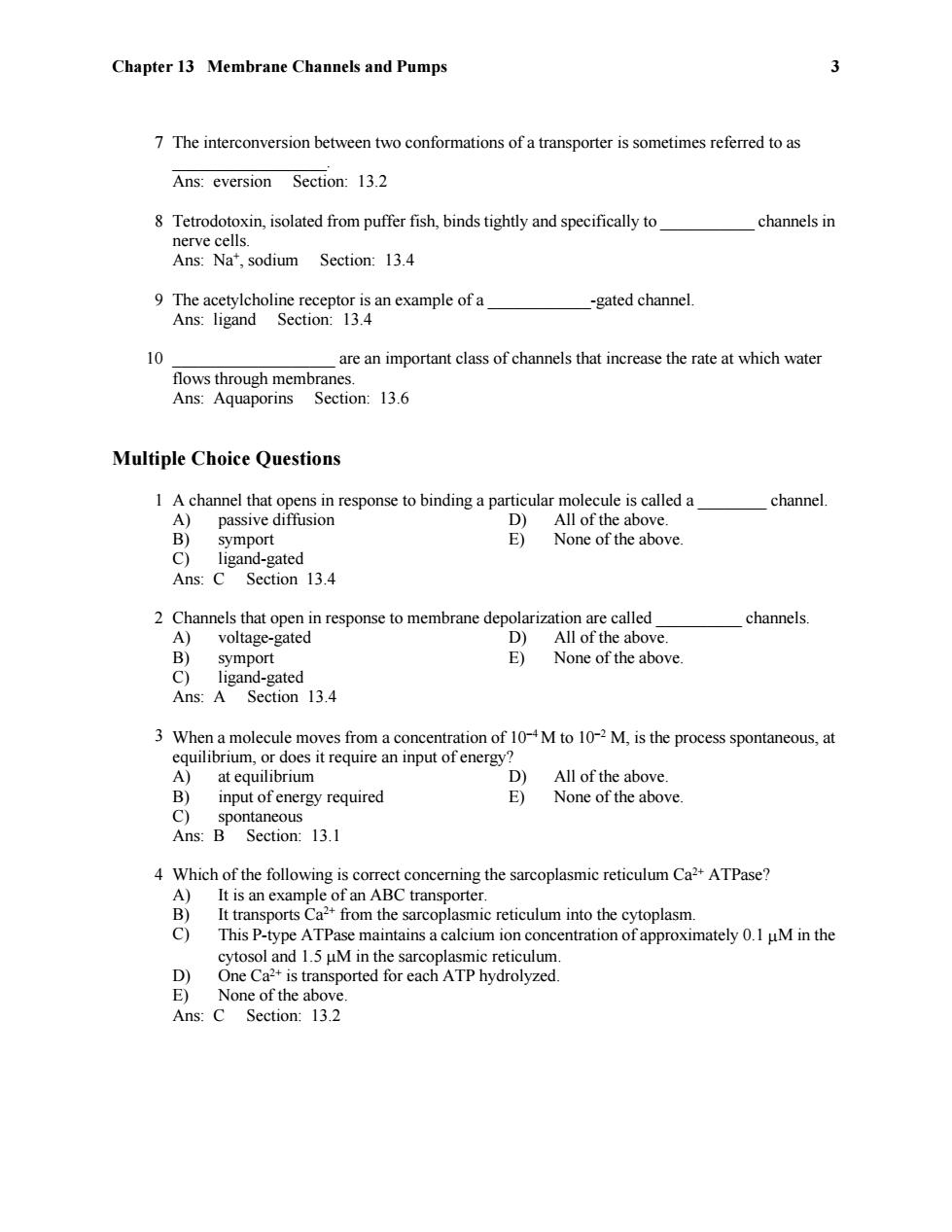
Chapter 13 Membrane Channels and Pumps 3 7 The interconversion between two conformations of a transporter is sometimes referred to as Ans:eversion Section:13.2 8 Tetrodotoxin,isolated from puffer fish,binds tightly and specifically to channels in nerve cells. Ans:Na,sodium Section:13.4 9 The acetylcholine receptor is an example of a -gated channel. Ans:ligand Section:13.4 10 are an important class of channels that increase the rate at which water flows through membranes. Ans:Aquaporins Section:13.6 Multiple Choice Questions 1 A channel that opens in response to binding a particular molecule is called a channel. A) passive diffusion D) All of the above. B) symport E) None of the above. C) ligand-gated Ans:C Section 13.4 2 Channels that open in response to membrane depolarization are called channels A) voltage-gated D) All of the above. symport E) None of the above. C) ligand-gated Ans:A Section 13.4 3 When a molecule moves from a concentration of 10-M to 10-2M,is the process spontaneous,at equilibrium,or does it require an input of energy? A) at equilibrium D) All of the above B) input of energy required E) None of the above. spontaneous Ans:B Section:13.1 4 Which of the following is correct concerning the sarcoplasmic reticulum Ca2+ATPase? A)It is an example of an ABC transporter. B) It transports Ca2+from the sarcoplasmic reticulum into the cytoplasm. C) This P-type ATPase maintains a calcium ion concentration of approximately 0.1 uM in the cytosol and 1.5 uM in the sarcoplasmic reticulum D) One Ca2+is transported for each ATP hydrolyzed. E)None of the above. Ans:C Section:13.2
Chapter 13 Membrane Channels and Pumps 3 7 The interconversion between two conformations of a transporter is sometimes referred to as __________________. Ans: eversion Section: 13.2 8 Tetrodotoxin, isolated from puffer fish, binds tightly and specifically to ___________ channels in nerve cells. Ans: Na + , sodium Section: 13.4 9 The acetylcholine receptor is an example of a ____________-gated channel. Ans: ligand Section: 13.4 10 ___________________ are an important class of channels that increase the rate at which water flows through membranes. Ans: Aquaporins Section: 13.6 Multiple Choice Questions 1 A channel that opens in response to binding a particular molecule is called a ________ channel. A) passive diffusion D) All of the above. B) symport E) None of the above. C) ligand-gated Ans: C Section 13.4 2 Channels that open in response to membrane depolarization are called __________ channels. A) voltage-gated D) All of the above. B) symport E) None of the above. C) ligand-gated Ans: A Section 13.4 3 When a molecule moves from a concentration of 10 4M to 10 2 M, is the process spontaneous, at equilibrium, or does it require an input of energy? A) at equilibrium D) All of the above. B) input of energy required E) None of the above. C) spontaneous Ans: B Section: 13.1 4 Which of the following is correct concerning the sarcoplasmic reticulum Ca 2+ ATPase? A) It is an example of an ABC transporter. B) It transports Ca 2+ from the sarcoplasmic reticulum into the cytoplasm. C) This P-type ATPase maintains a calcium ion concentration of approximately 0.1 M in the cytosol and 1.5 M in the sarcoplasmic reticulum. D) One Ca 2+ is transported for each ATP hydrolyzed. E) None of the above. Ans: C Section: 13.2
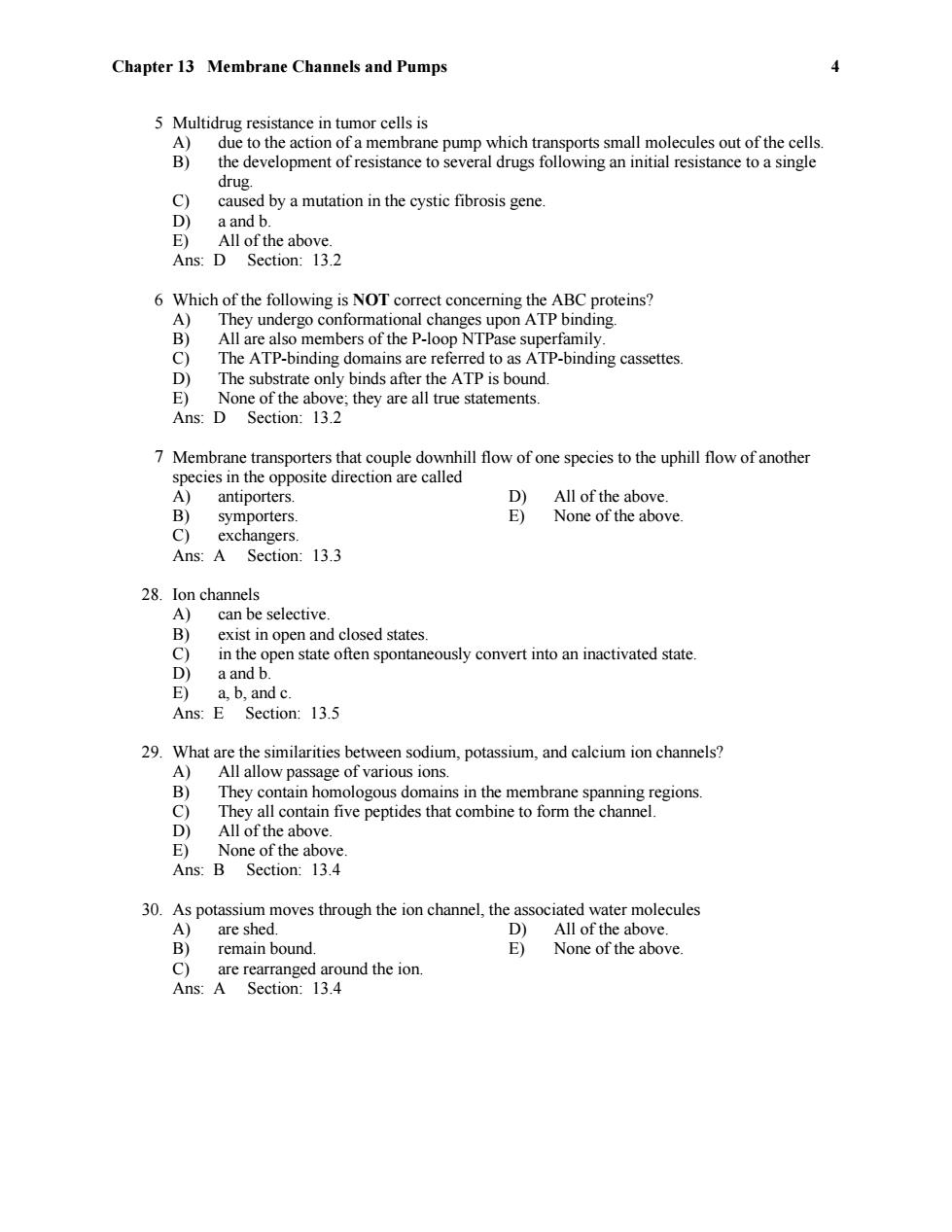
Chapter 13 Membrane Channels and Pumps 4 5 Multidrug resistance in tumor cells is A)due to the action of a membrane pump which transports small molecules out of the cells. B) the development of resistance to several drugs following an initial resistance to a single drug. C) caused by a mutation in the cystic fibrosis gene. D) a and b. E)All of the above. Ans:D Section:13.2 6 Which of the following is NOT correct concerning the ABC proteins? A) They undergo conformational changes upon ATP binding B) All are also members of the P-loop NTPase superfamily. C) The ATP-binding domains are referred to as ATP-binding cassettes. D) The substrate only binds after the ATP is bound. E)None of the above;they are all true statements. Ans:D Section:13.2 7 Membrane transporters that couple downhill flow of one species to the uphill flow of another species in the opposite direction are called A)antiporters. D All of the above. B) symporters. E) None of the above. c) exchangers. Ans:A Section:13.3 28.Ion channels A) can be selective. B) exist in open and closed states. C) in the open state often spontaneously convert into an inactivated state. D) a and b. E) a.b,and c. Ans:E Section:13.5 29.What are the similarities between sodium,potassium,and calcium ion channels? A)All allow passage of various ions. B) They contain homologous domains in the membrane spanning regions C) They all contain five peptides that combine to form the channel. D) All of the above. E)None of the above. Ans:B Section:13.4 30.As potassium moves through the ion channel,the associated water molecules A)are shed. D)All of the above. B) remain bound. E) None of the above. C)are rearranged around the ion. Ans:A Section:13.4
Chapter 13 Membrane Channels and Pumps 4 5 Multidrug resistance in tumor cells is A) due to the action of a membrane pump which transports small molecules out of the cells. B) the development of resistance to several drugs following an initial resistance to a single drug. C) caused by a mutation in the cystic fibrosis gene. D) a and b. E) All of the above. Ans: D Section: 13.2 6 Which of the following is NOT correct concerning the ABC proteins? A) They undergo conformational changes upon ATP binding. B) All are also members of the P-loop NTPase superfamily. C) The ATP-binding domains are referred to as ATP-binding cassettes. D) The substrate only binds after the ATP is bound. E) None of the above; they are all true statements. Ans: D Section: 13.2 7 Membrane transporters that couple downhill flow of one species to the uphill flow of another species in the opposite direction are called A) antiporters. D) All of the above. B) symporters. E) None of the above. C) exchangers. Ans: A Section: 13.3 28. Ion channels A) can be selective. B) exist in open and closed states. C) in the open state often spontaneously convert into an inactivated state. D) a and b. E) a, b, and c. Ans: E Section: 13.5 29. What are the similarities between sodium, potassium, and calcium ion channels? A) All allow passage of various ions. B) They contain homologous domains in the membrane spanning regions. C) They all contain five peptides that combine to form the channel. D) All of the above. E) None of the above. Ans: B Section: 13.4 30. As potassium moves through the ion channel, the associated water molecules A) are shed. D) All of the above. B) remain bound. E) None of the above. C) are rearranged around the ion. Ans: A Section: 13.4
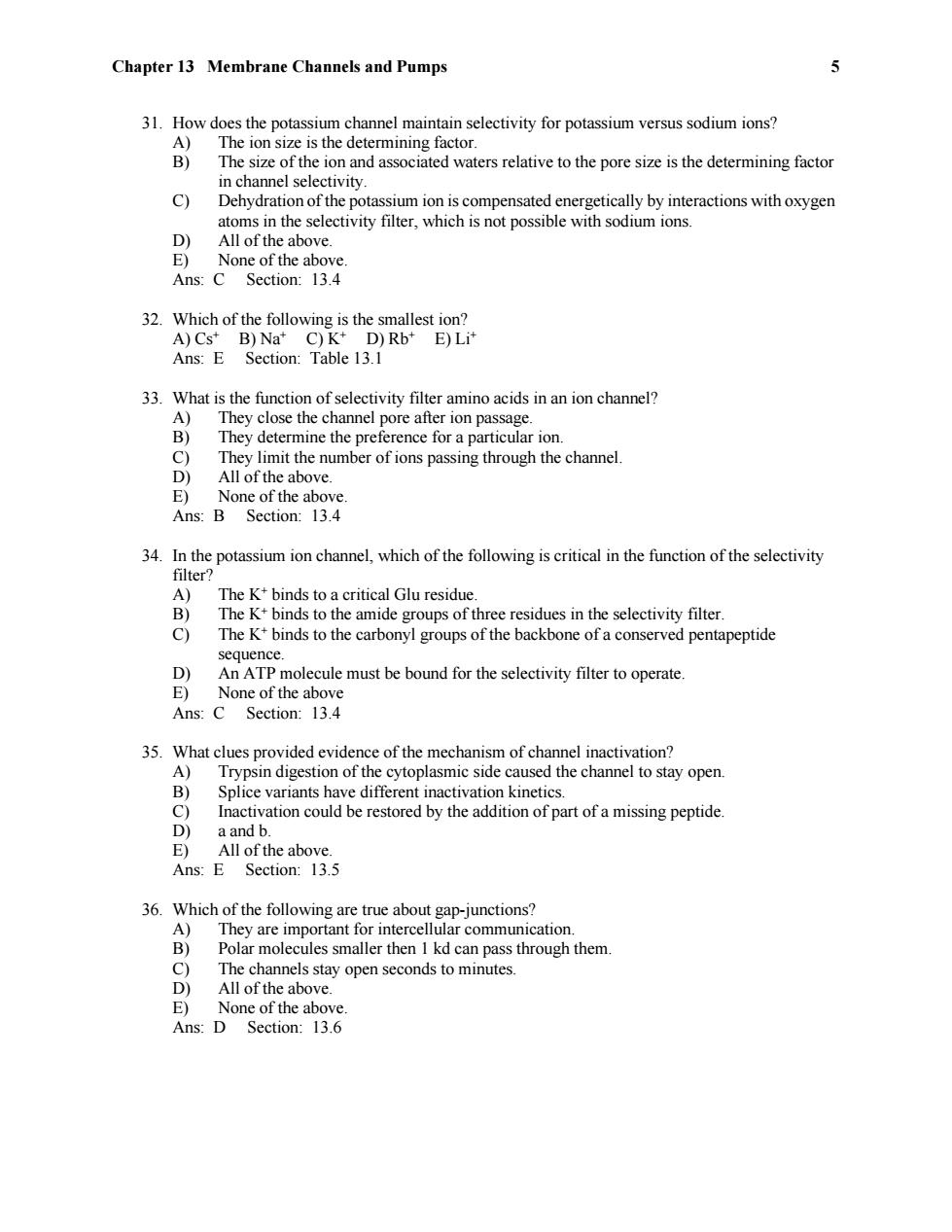
Chapter 13 Membrane Channels and Pumps 31.How does the potassium channel maintain selectivity for potassium versus sodium ions? A) The ion size is the determining factor. B) The size of the ion and associated waters relative to the pore size is the determining factor in channel selectivity. c) Dehydration of the potassium ion is compensated energetically by interactions with oxygen atoms in the selectivity filter,which is not possible with sodium ions. D) All of the above. E) None of the above. Ans:C Section:13.4 32.Which of the following is the smallest ion? A)Cs*B)Na+C)K+D)Rb+E)Lit Ans:E Section:Table 13.1 33.What is the function of selectivity filter amino acids in an ion channel? A)They close the channel pore after ion passage. B) They determine the preference for a particular ion. C) They limit the number of ions passing through the channel. D) All of the above. E) None of the above. Ans:B Section:13.4 34.In the potassium ion channel,which of the following is critical in the function of the selectivity filter? A The K+binds to a critical Glu residue. B) The K+binds to the amide groups of three residues in the selectivity filter. C) The K+binds to the carbonyl groups of the backbone of a conserved pentapeptide sequence. D) An ATP molecule must be bound for the selectivity filter to operate. E) None of the above Ans:C Section:13.4 35.What clues provided evidence of the mechanism of channel inactivation? A)Trypsin digestion of the cytoplasmic side caused the channel to stay open. B) Splice variants have different inactivation kinetics. C) Inactivation could be restored by the addition of part of a missing peptide. D) a and b. E)All of the above. Ans:E Section:13.5 36.Which of the following are true about gap-junctions? A)They are important for intercellular communication. B) Polar molecules smaller then 1 kd can pass through them. C) The channels stay open seconds to minutes. D)All of the above. E)None of the above. Ans:D Section:13.6
Chapter 13 Membrane Channels and Pumps 5 31. How does the potassium channel maintain selectivity for potassium versus sodium ions? A) The ion size is the determining factor. B) The size of the ion and associated waters relative to the pore size is the determining factor in channel selectivity. C) Dehydration of the potassium ion is compensated energetically by interactions with oxygen atoms in the selectivity filter, which is not possible with sodium ions. D) All of the above. E) None of the above. Ans: C Section: 13.4 32. Which of the following is the smallest ion? A) Cs + B) Na + C) K+ D) Rb + E) Li+ Ans: E Section: Table 13.1 33. What is the function of selectivity filter amino acids in an ion channel? A) They close the channel pore after ion passage. B) They determine the preference for a particular ion. C) They limit the number of ions passing through the channel. D) All of the above. E) None of the above. Ans: B Section: 13.4 34. In the potassium ion channel, which of the following is critical in the function of the selectivity filter? A) The K+ binds to a critical Glu residue. B) The K+ binds to the amide groups of three residues in the selectivity filter. C) The K+ binds to the carbonyl groups of the backbone of a conserved pentapeptide sequence. D) An ATP molecule must be bound for the selectivity filter to operate. E) None of the above Ans: C Section: 13.4 35. What clues provided evidence of the mechanism of channel inactivation? A) Trypsin digestion of the cytoplasmic side caused the channel to stay open. B) Splice variants have different inactivation kinetics. C) Inactivation could be restored by the addition of part of a missing peptide. D) a and b. E) All of the above. Ans: E Section: 13.5 36. Which of the following are true about gap-junctions? A) They are important for intercellular communication. B) Polar molecules smaller then 1 kd can pass through them. C) The channels stay open seconds to minutes. D) All of the above. E) None of the above. Ans: D Section: 13.6
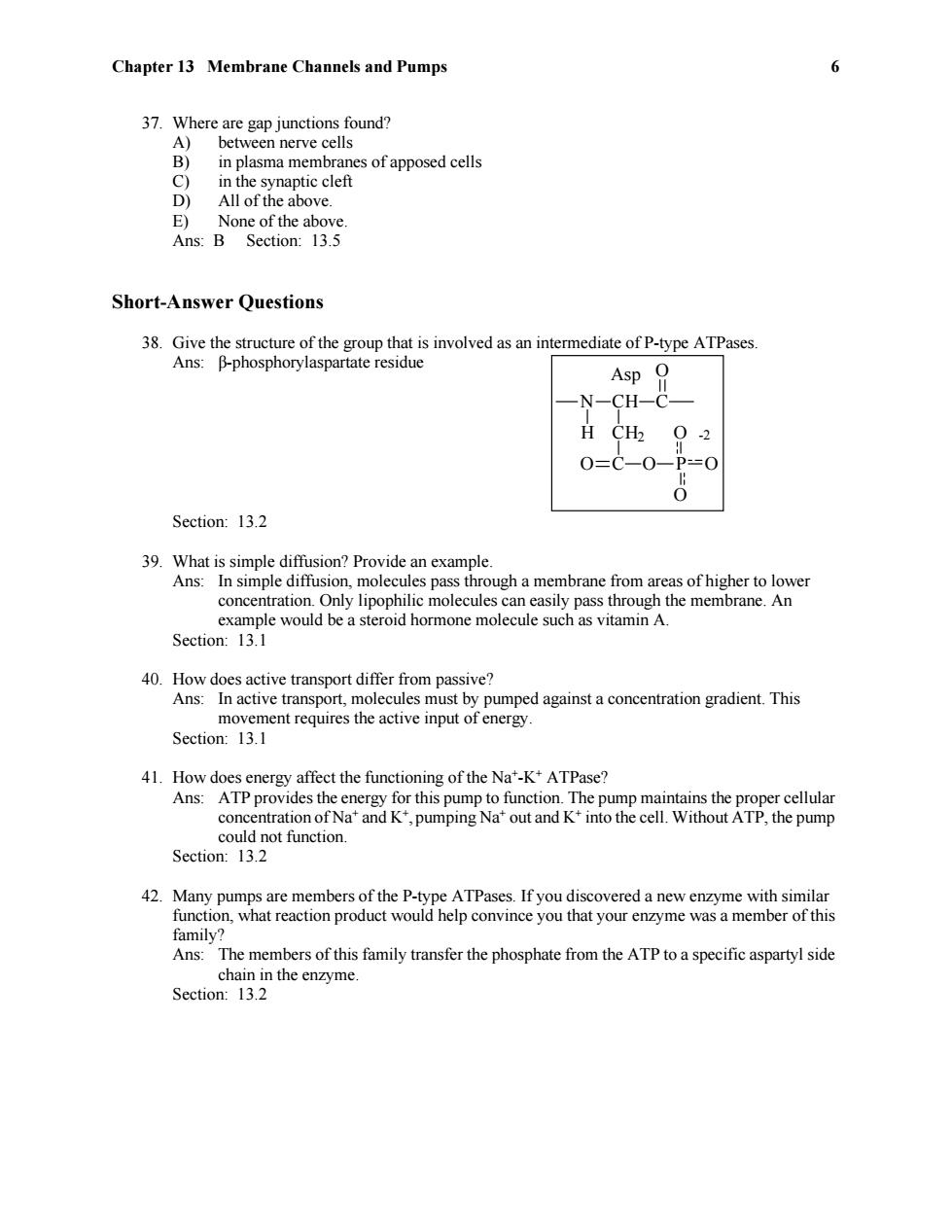
Chapter 13 Membrane Channels and Pumps 6 37.Where are gap junctions found? A) between nerve cells B) in plasma membranes of apposed cells C) in the synaptic cleft D All of the above. E)None of the above Ans:B Section:13.5 Short-Answer Questions 38.Give the structure of the group that is involved as an intermediate of P-type ATPases. Ans:B-phosphorylaspartate residue Asp 0 -N-CH-C- H CH 02 0=C-0-P=0 Section:13.2 39.What is simple diffusion?Provide an example. Ans:In simple diffusion,molecules pass through a membrane from areas of higher to lower concentration.Only lipophilic molecules can easily pass through the membrane.An example would be a steroid hormone molecule such as vitamin A. Section:13.1 40.How does active transport differ from passive? Ans:In active transport,molecules must by pumped against a concentration gradient.This movement requires the active input of energy. Section:13.1 41.How does energy affect the functioning of the Na'-K*ATPase? Ans:ATP provides the energy for this pump to function.The pump maintains the proper cellular concentration of Na'and K*,pumping Na*out and K+into the cell.Without ATP,the pump could not function. Section:13.2 42.Many pumps are members of the P-type ATPases.If you discovered a new enzyme with similar function,what reaction product would help convince you that your enzyme was a member of this family? Ans:The members of this family transfer the phosphate from the ATP to a specific aspartyl side chain in the enzyme. Section:13.2
Chapter 13 Membrane Channels and Pumps 6 37. Where are gap junctions found? A) between nerve cells B) in plasma membranes of apposed cells C) in the synaptic cleft D) All of the above. E) None of the above. Ans: B Section: 13.5 Short-Answer Questions 38. Give the structure of the group that is involved as an intermediate of P-type ATPases. Ans: β-phosphorylaspartate residue N H CH C O CH2 O C O P O O O -2 Asp Section: 13.2 39. What is simple diffusion? Provide an example. Ans: In simple diffusion, molecules pass through a membrane from areas of higher to lower concentration. Only lipophilic molecules can easily pass through the membrane. An example would be a steroid hormone molecule such as vitamin A. Section: 13.1 40. How does active transport differ from passive? Ans: In active transport, molecules must by pumped against a concentration gradient. This movement requires the active input of energy. Section: 13.1 41. How does energy affect the functioning of the Na + -K+ ATPase? Ans: ATP provides the energy for this pump to function. The pump maintains the proper cellular concentration of Na + and K+ , pumping Na + out and K+ into the cell. Without ATP, the pump could not function. Section: 13.2 42. Many pumps are members of the P-type ATPases. If you discovered a new enzyme with similar function, what reaction product would help convince you that your enzyme was a member of this family? Ans: The members of this family transfer the phosphate from the ATP to a specific aspartyl side chain in the enzyme. Section: 13.2
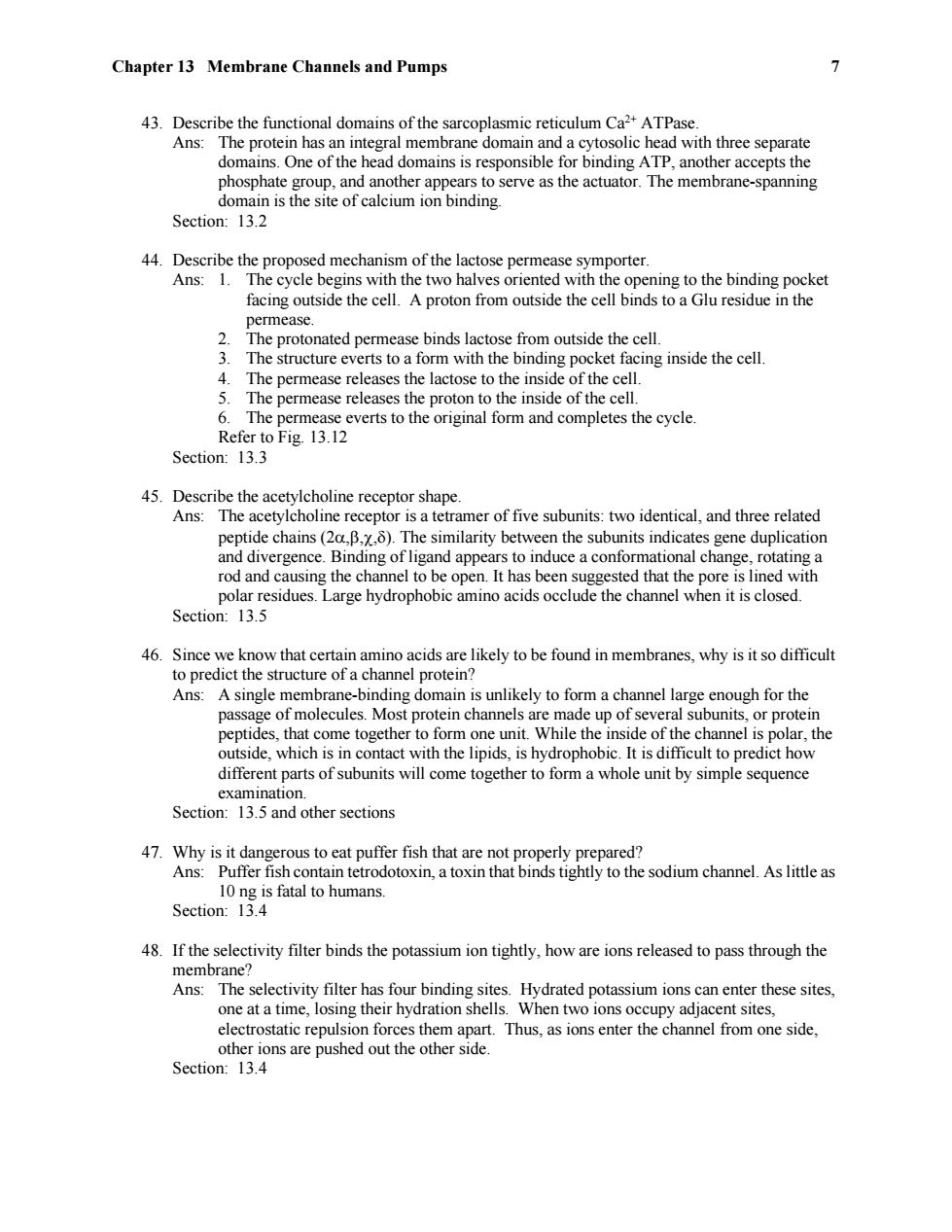
Chapter 13 Membrane Channels and Pumps 7 43.Describe the functional domains of the sarcoplasmic reticulum Ca2+ATPase. Ans:The protein has an integral membrane domain and a cytosolic head with three separate domains.One of the head domains is responsible for binding ATP,another accepts the phosphate group,and another appears to serve as the actuator.The membrane-spanning domain is the site of calcium ion binding. Section:13.2 44.Describe the proposed mechanism of the lactose permease symporter. Ans:1.The cycle begins with the two halves oriented with the opening to the binding pocket facing outside the cell.A proton from outside the cell binds to a Glu residue in the permease. 2. The protonated permease binds lactose from outside the cell. 3.The structure everts to a form with the binding pocket facing inside the cell. 4.The permease releases the lactose to the inside of the cell 5.The permease releases the proton to the inside of the cell. 6.The permease everts to the original form and completes the cycle. Refer to Fig.13.12 Section:13.3 45.Describe the acetylcholine receptor shape. Ans:The acetylcholine receptor is a tetramer of five subunits:two identical,and three related peptide chains(2a,B,x,8).The similarity between the subunits indicates gene duplication and divergence.Binding of ligand appears to induce a conformational change,rotating a rod and causing the channel to be open.It has been suggested that the pore is lined with polar residues.Large hydrophobic amino acids occlude the channel when it is closed. Section:13.5 46.Since we know that certain amino acids are likely to be found in membranes,why is it so difficult to predict the structure of a channel protein? Ans:A single membrane-binding domain is unlikely to form a channel large enough for the passage of molecules.Most protein channels are made up of several subunits,or protein peptides,that come together to form one unit.While the inside of the channel is polar,the outside,which is in contact with the lipids,is hydrophobic.It is difficult to predict how different parts of subunits will come together to form a whole unit by simple sequence examination. Section:13.5 and other sections 47.Why is it dangerous to eat puffer fish that are not properly prepared? Ans:Puffer fish contain tetrodotoxin,a toxin that binds tightly to the sodium channel.As little as 10 ng is fatal to humans. Section:13.4 48.If the selectivity filter binds the potassium ion tightly,how are ions released to pass through the membrane? Ans:The selectivity filter has four binding sites.Hydrated potassium ions can enter these sites, one at a time,losing their hydration shells.When two ions occupy adjacent sites, electrostatic repulsion forces them apart.Thus,as ions enter the channel from one side, other ions are pushed out the other side. Section:13.4
Chapter 13 Membrane Channels and Pumps 7 43. Describe the functional domains of the sarcoplasmic reticulum Ca 2+ ATPase. Ans: The protein has an integral membrane domain and a cytosolic head with three separate domains. One of the head domains is responsible for binding ATP, another accepts the phosphate group, and another appears to serve as the actuator. The membrane-spanning domain is the site of calcium ion binding. Section: 13.2 44. Describe the proposed mechanism of the lactose permease symporter. Ans: 1. The cycle begins with the two halves oriented with the opening to the binding pocket facing outside the cell. A proton from outside the cell binds to a Glu residue in the permease. 2. The protonated permease binds lactose from outside the cell. 3. The structure everts to a form with the binding pocket facing inside the cell. 4. The permease releases the lactose to the inside of the cell. 5. The permease releases the proton to the inside of the cell. 6. The permease everts to the original form and completes the cycle. Refer to Fig. 13.12 Section: 13.3 45. Describe the acetylcholine receptor shape. Ans: The acetylcholine receptor is a tetramer of five subunits: two identical, and three related peptide chains (2,,,). The similarity between the subunits indicates gene duplication and divergence. Binding of ligand appears to induce a conformational change, rotating a rod and causing the channel to be open. It has been suggested that the pore is lined with polar residues. Large hydrophobic amino acids occlude the channel when it is closed. Section: 13.5 46. Since we know that certain amino acids are likely to be found in membranes, why is it so difficult to predict the structure of a channel protein? Ans: A single membrane-binding domain is unlikely to form a channel large enough for the passage of molecules. Most protein channels are made up of several subunits, or protein peptides, that come together to form one unit. While the inside of the channel is polar, the outside, which is in contact with the lipids, is hydrophobic. It is difficult to predict how different parts of subunits will come together to form a whole unit by simple sequence examination. Section: 13.5 and other sections 47. Why is it dangerous to eat puffer fish that are not properly prepared? Ans: Puffer fish contain tetrodotoxin, a toxin that binds tightly to the sodium channel. As little as 10 ng is fatal to humans. Section: 13.4 48. If the selectivity filter binds the potassium ion tightly, how are ions released to pass through the membrane? Ans: The selectivity filter has four binding sites. Hydrated potassium ions can enter these sites, one at a time, losing their hydration shells. When two ions occupy adjacent sites, electrostatic repulsion forces them apart. Thus, as ions enter the channel from one side, other ions are pushed out the other side. Section: 13.4

Chapter 13 Membrane Channels and Pumps 8 49.What is the"ball-and-chain"model? Ans:"Ball-and-chain"is a model of inactivation of a pore by occlusion.In this model a group of amino acids forms a"ball,"which is attached by a flexible peptide to the rest of the protein. After the channel opens,the ball moves into a site that blocks the channel,thus quickly inactivating the channel function. Section:13.4 50.Why are gap junctions sealed when high concentrations of calcium ions and protons are present? Ans:These conditions are common when cells are dying or traumatized.Under these conditions the gap junctions close,so unhealthy neighbors do not compromise the healthy cells. Section:13.5 51.What are some of the functions of gap cells? Ans:In addition to intracellular communication,the junctions are important in nourishment of cells,coupling with ion transport,development,and differentiation. Section:13.5 52.Describe how a voltage-gated channel operates. Ans:The voltage-gated channel is composed of segments S1-S6.The pore is formed by S5 and S6,and the "voltage-sensing paddles"that close the channel are composed of S1-S4.The paddles lie in the"down"position below the closed channel.Membrane depolarization pulls these channels through the membrane opening the channel. Section:13.4;Figure 13.23
Chapter 13 Membrane Channels and Pumps 8 49. What is the “ball-and-chain” model? Ans: “Ball-and-chain” is a model of inactivation of a pore by occlusion. In this model a group of amino acids forms a “ball,” which is attached by a flexible peptide to the rest of the protein. After the channel opens, the ball moves into a site that blocks the channel, thus quickly inactivating the channel function. Section: 13.4 50. Why are gap junctions sealed when high concentrations of calcium ions and protons are present? Ans: These conditions are common when cells are dying or traumatized. Under these conditions the gap junctions close, so unhealthy neighbors do not compromise the healthy cells. Section: 13.5 51. What are some of the functions of gap cells? Ans: In addition to intracellular communication, the junctions are important in nourishment of cells, coupling with ion transport, development, and differentiation. Section: 13.5 52. Describe how a voltage-gated channel operates. Ans: The voltage-gated channel is composed of segments S1S6. The pore is formed by S5 and S6, and the “voltage-sensing paddles” that close the channel are composed of S1S4. The paddles lie in the “down” position below the closed channel. Membrane depolarization pulls these channels through the membrane opening the channel. Section: 13.4; Figure 13.23